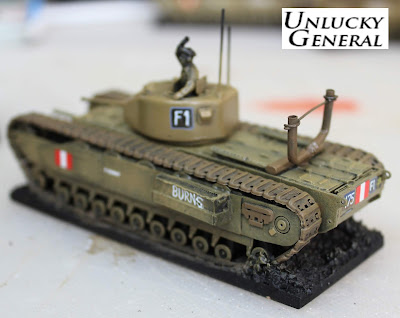Marking the Churchills: My Dieppe Part 3
I can now see the light at the end of what's been too long a tunnel. So many distractions have diverted my energies away from these models but I'm pushing on. Thanks to my friends visiting me last month I secured some Windsor & Newton oil paints ready for pin washing but first I had to mark up the MkI and MkII models.
Thanks to my Dieppe Through the Lens reference work (Henry & Pallud) I know the markings for each vehicle including reference shots. BUT, this was to be a hand painted exercise on the most part due to a couple of deficiencies.
The Hasagewa models come with incorrect unit markings which were 175 (in white) on blue over brown and lacked the specific formation sign for Dieppe - gold maple leaf with black ram. Furthermore, the vehicle numbers and names of the tanks were all going to have to be hand painted anyway.
The only things I didn't have to paint (with one exception) was the Canadian national markings (red and white) for which the kits did come supplied.
Perrett, Sarson & Chappell (Osprey New Vanguard 4) reckon on the vehicle numbers being white alpha/numeric over black with grey borders but everywhere else they are depicted light to medium (even loud) blue. I split the difference and went a light grey/blue which is more muted and pleasing to my eyes.
For those of you who might be really up on your Dieppe, you will notice my serial numbers are not accurate. My only concession to the exact vehicle serial numbers was using longer and shorter sequences when called for when referring to my charts. Oh and as you might have guessed, these are also the decals from the kits.
Whilst hand painting vehicle signs and insignia, it's never going to be as well formed as a decal or printing your own. As I keep saying; however, these are 1/72 scale models used for wargaming where we move them about largely at arms length. The hand painting will be just fine. The worst they will ever look is under the macro-lens and on this blog.
Note the curious numbering on 'Bolster' (above) - I love how they painted the F3. As it happens, F3 'Company' didn't have any photos so I'm assuming they painted its F3 in the circle in the same manner. Now it's onto the weathering.
Thanks to my Dieppe Through the Lens reference work (Henry & Pallud) I know the markings for each vehicle including reference shots. BUT, this was to be a hand painted exercise on the most part due to a couple of deficiencies.
The Hasagewa models come with incorrect unit markings which were 175 (in white) on blue over brown and lacked the specific formation sign for Dieppe - gold maple leaf with black ram. Furthermore, the vehicle numbers and names of the tanks were all going to have to be hand painted anyway.
The only things I didn't have to paint (with one exception) was the Canadian national markings (red and white) for which the kits did come supplied.
Perrett, Sarson & Chappell (Osprey New Vanguard 4) reckon on the vehicle numbers being white alpha/numeric over black with grey borders but everywhere else they are depicted light to medium (even loud) blue. I split the difference and went a light grey/blue which is more muted and pleasing to my eyes.
For those of you who might be really up on your Dieppe, you will notice my serial numbers are not accurate. My only concession to the exact vehicle serial numbers was using longer and shorter sequences when called for when referring to my charts. Oh and as you might have guessed, these are also the decals from the kits.
Whilst hand painting vehicle signs and insignia, it's never going to be as well formed as a decal or printing your own. As I keep saying; however, these are 1/72 scale models used for wargaming where we move them about largely at arms length. The hand painting will be just fine. The worst they will ever look is under the macro-lens and on this blog.
Note the curious numbering on 'Bolster' (above) - I love how they painted the F3. As it happens, F3 'Company' didn't have any photos so I'm assuming they painted its F3 in the circle in the same manner. Now it's onto the weathering.







Comments
Post a Comment